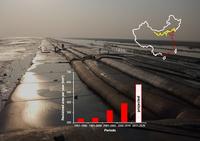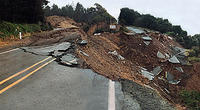-
Nimble robot expedites, simplifies water pipe inspections
Between 30 and 50 percent of Europe’s drinking water are being lost every year due to pipe leakages. Norwegian researchers have developed an inspection methodology for water distribution grids. A long, torpedo-like and propeller-driven robot is guided through the water and district heating pipe systems. It is equipped with sixty-four large ultrasound transducers which transmit and receive ultrasound signals. It collects data which enable us calculate the thickness of, and levels of corrosion in, the pipes.
-
-
Mobile radio passive radar helps protect ports, coastal communities
Airports are subject to careful security surveillance, but many coastal towns and ports are not; they often lack radar installations to keep track of small boats, meaning that terrorists could easily use speedboats to approach the coastline and bring explosives on land. Now, researchers have developed a passive surveillance system for littoral regions based on mobile radio illumination called Passive Coherent Location (PCL). It passively employs the continuous radio signals emitted by cell towers to detect suspicious boats, including those speedboats favored by pirates for approaching cargo ships. The fusion with electro-optical or infrared systems allows the classification of the different targets.
-
-
Court: San Diego infrastructure, mass transportation plans fail to meet climate tests
Two lawsuits by environmental groups including the Sierra Club, the Cleveland National Forest Foundation, and the Center for Biological Diversity, against the San Diego County government and the San Diego Association of Governments (SANDAG) could force the region to rethink how it plans to spend billions of dollars in the next few decades on infrastructure and mass transportation projects.
-
-
Reducing the impact of extreme weather
How do we reduce the impact of extreme weather today while preparing ourselves for future changes? What can we do to build our resilience? A new report from the Royal Society investigates these, and other, key questions to help inform important decisions about adaptation and risk reduction that are being made at global, national and local levels.
-
-
New report highlights “significant and increasing” risks from extreme weather

A comprehensive new report, published by the Royal Society, indicates that exposure of human populations to extreme weather is set to increase as global climate and population size, location, and age continue to change. The report focuses on the risks to people from floods, droughts, and heatwaves. These are some of the most frequent and damaging extreme events that currently occur and their impacts will change with the changing climate. The report also calls for changes to global financial accounting and regulation to ensure that extreme weather risk is made explicit. At present, these risks are not systematically factored into investors’ valuations or assessed by creditors.
-
-
California’s early-warning ShakeAlert system to be rolled out next year
Officials in California expect the state’s ShakeAlertsystem to be available to some schools, fire stations, and more private companies early next year. Until now, only earthquake researchers, some government agencies, and a few private firms have received alerts from the statewide earthquake early warning system. The 2015 expansion will occur as long as Congress approves a $5 million funding request that has passed committees in both the Senate and House. A full vote on the budget was delayed until after the midterm elections.
-
-
Resilience of California’s transportation infrastructure questioned
A significant number of bridges and elevated roadways lie above or close to active fault lines, and Californians often wonder how the state’s towering interchanges and freeway network would perform during a major earthquake.The California Department of Transportation (Caltrans) has spent over $13 billion in the last forty years to reinforce vulnerable bridges and interchanges. Caltrans officials note that during a major earthquake, freeways are likely to sustain significant damage, but engineers feel confident that freeways will not collapse.
-
-
Here’s how to fix America’s crumbling bridges

There are about 600,000 bridges in the United States, and about one in four is classified as functionally obsolete or structurally deficient. This doesn’t mean they’re in danger of imminent collapse; they may be simply too narrow or built for lighter traffic than today’s standards. Bridges that can’t support heavy trucks have weight restrictions posted. There are plenty of repairs that need to be done. With government funding for infrastructure projects being so tight, an alternative has arisen in what are called public-private partnerships, often abbreviated PPP or P3. In this arrangement, private investors assume the responsibility for financing and building a bridge or highway, and the investors are granted the right to collect tolls for what may be decades. The investors naturally believe they will realize a good return on their investment, even after they pay the public partner a sizable sum upfront for the concession. This upfront payment can be in the billions of dollars, which can be very tempting for a state or municipality struggling to balance its budget.
-
-
A malware more sophisticated than Stuxnet discovered
Security experts at Symantechave discovered the world’s most sophisticated computer malware, Regin. Thought to have been created by a Western intelligence agency, and in many respects more advanced than Stuxnet — which was developed by the U.S. and Israeli government in 2010 to hack the Iranian nuclear program — Regin has targeted Russian, Saudi Arabian, Mexican, Irish, and Iranian Internet service providers and telecoms companies. “Nothing else comes close to this … nothing else we look at compares,” said one security expert.
-
-
Iran may resume cyberattacks on U.S. if nuclear deal is not reached
A failure for the United States to reach a nuclear deal with Iran could result in more cyberattacks against U.S. companies, House Intelligence Committeechairman Mike Rogers (R-Michigan) said. Cyberattacks by Tehran declined dramatically after the United States, other permanent members of the Security Council, and Germany agreed to an interim nuclear deal with Iran in 2013, but should the parties fail to reach a permanent nuclear deal by the newly set March 2015 and July 2015 deadlines, financial firms, oil and gas companies, and water filtration systems could be targets of malware from Iran’s cyber army.
-
-
Cyber experts divided over the scope of damage of a cyberattack on U.S.
Citing the risks of lack of preparation against future cyberattacks and the absence of security infrastructure, a new report urges across the board updates in the domain of cybersecurity. Most of the experts interviewed for the report pointed to the Stuxnet malware, which damaged Iranian nuclear-enrichment centrifuges and other nuclear-related machinery in 2010, as an example of the sort of future attacks that could disable and destroy vital infrastructure such as power grids, air-traffic controls, and banking institutions.
-
-
NSA director: China and “one or two” other nations can damage U.S. critical infrastructure
Adm. Michael Rogers, director of the National Security Agency and head of U.S. Cyber Command, told lawmakers yesterday that China and “one or two” other countries are capable of mounting cyberattacks which would paralyze the U.S electric grid and other critical infrastructure systems across the country. A cyberattacks of such scope has been discussed in the past – it was even dubbed a “cyber Pearl Harbor” – but Rogers was the first high official to confirm that such a crippling attack on the United States was not a mere speculation. Rogers said U.S. adversaries are conducting electronic “reconnaissance” on a regular basis so that they will be well-positioned to damage and disrupt the industrial control systems which run chemical facilities, nuclear power plants, water treatment facilities, dams, and much more.
-
-
China’s second “great wall” is not so great

China’s coastal regions are only 13 percent of the country’s land area, but contribute 60 percent of its gross domestic product. With that come layers of incentives to turn lush wetlands into engines of development and industry. A new study finds that China’s second great wall, a vast seawall covering more than half of the country’s mainland coastline, is a foundation for financial gain - and also a dyke holding a swelling rush of ecological woes.
-
-
New technology increases awareness of landslide risks

Engineers have created a new way to use lidar technology to identify and classify landslides on a landscape scale, which may revolutionize the understanding of landslides in the United States and reveal them to be far more common and hazardous than often understood. The new, non-subjective technology can analyze and classify the landslide risk in an area of fifty or more square miles in about thirty minutes — a task that previously might have taken an expert several weeks to months. It can also identify risks common to a broad area rather than just an individual site.
-
-
U.S. spends about $10 billion a year to protect the nation's digital infrastructure
U.S. intelligence agencies have designated cyberattacks as the most alarming threat to national security. The federal government is spending roughly $10 billion a year to protect the nation’s digital infrastructure, but hackers, some sponsored by nation-states, are successfully infiltrating civilian and military networks.Professionals from DHS, the Pentagon, and private contractors all work together in U.S. cyber centers to detect, prevent, respond, and mitigate incoming and existing cyberattacks. Several of the U.S. top cybersecurity labs are housed in nondescript office buildings with no government seals or signs.
-
- All
- Regional
- Water
- Biometrics
- Borders/Immig
- Business
- Cybersecurity
- Detection
- Disasters
- Government
- Infrastructure
- International
- Public health
- Public Safety
- Communication interoperabillity
- Emergency services
- Emergency medical services
- Fire
- First response
- IEDs
- Law Enforcement
- Law Enforcement Technology
- Military technology
- Nonlethal weapons
- Nuclear weapons
- Personal protection equipment
- Police
- Notification /alert systems
- Situational awareness
- Weapons systems
- Sci-Tech
- Sector Reports
- Surveillance
- Transportation
Advertising & Marketing: advertise@newswirepubs.com
Editorial: editor@newswirepubs.com
General: info@newswirepubs.com
2010-2011 © News Wire Publications, LLC News Wire Publications, LLC
220 Old Country Road | Suite 200 | Mineola | New York | 11501
Permissions and Policies
Editorial: editor@newswirepubs.com
General: info@newswirepubs.com
2010-2011 © News Wire Publications, LLC News Wire Publications, LLC
220 Old Country Road | Suite 200 | Mineola | New York | 11501
Permissions and Policies
